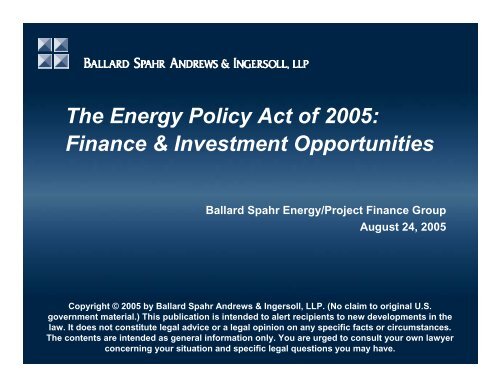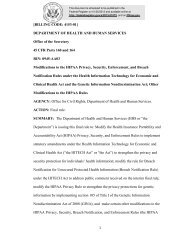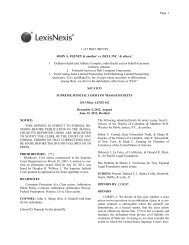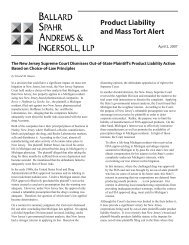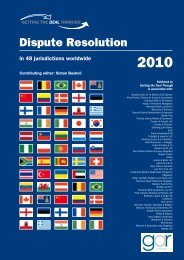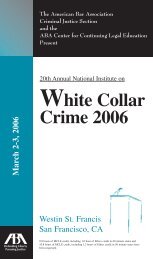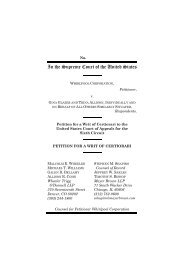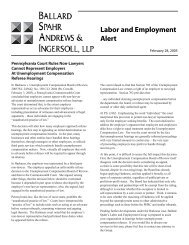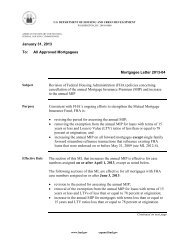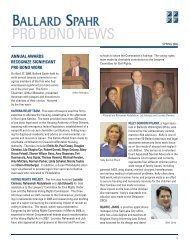The Energy Policy Act of 2005 - Ballard Spahr LLP
The Energy Policy Act of 2005 - Ballard Spahr LLP
The Energy Policy Act of 2005 - Ballard Spahr LLP
Create successful ePaper yourself
Turn your PDF publications into a flip-book with our unique Google optimized e-Paper software.
<strong>The</strong> <strong>Energy</strong> <strong>Policy</strong> <strong>Act</strong> <strong>of</strong> <strong>2005</strong>:<br />
Finance & Investment Opportunities<br />
<strong>Ballard</strong> <strong>Spahr</strong> <strong>Energy</strong>/Project Finance Group<br />
August 24, <strong>2005</strong><br />
Copyright © <strong>2005</strong> by <strong>Ballard</strong> <strong>Spahr</strong> Andrews & Ingersoll, <strong>LLP</strong>. (No claim to original U.S.<br />
government material.) This publication is intended to alert recipients to new developments in the<br />
law. It does not constitute legal advice or a legal opinion on any specific facts or circumstances.<br />
<strong>The</strong> contents are intended as general information only. You are urged to consult your own lawyer<br />
concerning your situation and specific legal questions you may have.
Agenda<br />
• Electricity Regulation and Transmission<br />
• Coal and Alternative Technologies<br />
• Nuclear<br />
• Renewable Electricity<br />
• LNG and Gas<br />
• Petroleum<br />
• Renewable Motor Fuels and Ethanol<br />
• Hydrogen<br />
2
Electricity Regulation<br />
and<br />
Transmission
Electricity and Transmission<br />
• PUHCA Repeal Facilitates Investment and Mergers<br />
– PUHCA regulation <strong>of</strong> holding company structures by the SEC<br />
discouraged acquisition <strong>of</strong> utilities and electric facilities<br />
– Repeal <strong>of</strong> PUHCA means that many more types <strong>of</strong> buyers can<br />
freely invest in the electric industry and that holding companies<br />
can invest more broadly<br />
– More utility mergers can occur in absence <strong>of</strong> PUHCA’s<br />
“integration” requirement<br />
– PUHCA replaced with access by FERC and state commissions<br />
to books and records <strong>of</strong> holding companies (EWG and FUCO<br />
determinations will still be <strong>of</strong> value)<br />
4
Electricity and Transmission<br />
• FERC’s Merger Review Authority Modified<br />
– FERC will review transactions valued above $10 million,<br />
including: sales and leases <strong>of</strong> transmission and generation<br />
facilities; purchases <strong>of</strong> portions <strong>of</strong> utilities; purchases or<br />
leases <strong>of</strong> existing generation facilities; merger <strong>of</strong> holding<br />
company with another utility<br />
– Standard <strong>of</strong> review: transaction must be consistent with the<br />
public interest and not cross-subsidize non-utility activities<br />
5
Electricity and Transmission<br />
• PURPA Changes Affect New Qualifying Facilities<br />
– PURPA modified to:<br />
• Allow exemption <strong>of</strong> utilities from mandatory purchase <strong>of</strong> electricity<br />
from new qualifying facilities (“QFs”) if QFs have nondiscriminatory<br />
access to meaningful competitive wholesale and retail outlets<br />
(e.g., RTO/ISO bidding markets)<br />
• Require FERC to tighten technical requirement for new<br />
cogeneration QFs<br />
– Existing contracts and QFs not affected<br />
– Limitation on ownership <strong>of</strong> QFs by utilities discontinued<br />
6
Electricity and Transmission<br />
• Support for Investment in New Transmission Facilities<br />
– New conventional and merchant transmission facilities have<br />
been stymied by state siting and permitting processes<br />
– <strong>Act</strong> permits FERC to issue construction permits for high-priority<br />
transmission projects if states do not have appropriate authority<br />
or withhold permits inappropriately<br />
– Permittees can obtain rights <strong>of</strong> way through eminent domain<br />
actions<br />
7
Electricity and Transmission<br />
• Support for Investment in New Transmission Facilities (cont’d)<br />
– Western Area and Southwestern Power Administrations may enter<br />
into public-private financial arrangements for new or upgraded<br />
transmission facilities (but private sector “contribution” limited to<br />
$100 million over 2006-2015)<br />
– Within 1 year, FERC must issue rule providing incentive-based<br />
(including performance-based) transmission rate treatments that<br />
promote capital investment, provide a return <strong>of</strong> equity to attract new<br />
investment, and encourage new transmission technologies<br />
– Reduces tax depreciation recovery period from 20 years to 15 years<br />
– Permits transmission owners selling facilities to independent<br />
transmission providers to amortize gain over 8 years<br />
8
Coal and Alternative Technologies
Coal and Alternative Technologies<br />
• DOE Grants for Clean Coal Projects<br />
Authorizes $200 million per year, for fiscal years 2006 - 2014,<br />
to commercial scale demonstration projects<br />
– At least 70% earmarked to coal-based gasification technology<br />
projects<br />
– Projects must be likely to generate overall cost reductions and<br />
improve coal competitiveness. Methods and equipment must be<br />
applicable to 25% <strong>of</strong> current coal-fired generators<br />
– Federal assistance capped at 50% <strong>of</strong> project cost<br />
10
Coal and Alternative Technologies<br />
• Clean Air Coal Program<br />
Authorizes grants, loans, cooperative agreements.<br />
Similar cost sharing provisions as for Clean Coal projects.<br />
Two types <strong>of</strong> commercial application projects:<br />
– Equipment and processes that improve energy efficiency or cut<br />
emissions. Total <strong>of</strong> $2.5 billion authorized for fiscal years 2007<br />
through 2013.<br />
• Between 25% and 75% <strong>of</strong> projects must be for sole purpose <strong>of</strong><br />
generating electricity, priority given to demonstrated processes and<br />
equipment that are not yet cost-effective<br />
– Upgrades to existing coal-fired plants to deploy advanced pollution<br />
control equipment and processes. Total <strong>of</strong> $500 million authorized<br />
for fiscal years 2007 through 2011.<br />
• Priority on projects with significant air quality improvement, collection<br />
<strong>of</strong> more than one pollutant, or that use waste byproducts<br />
11
Coal and Alternative Technologies<br />
• Tax Incentives for Coal and Other Alternative Fuel Facilities<br />
– Three new investment tax credits<br />
• Advanced coal credit projects credits<br />
– 20% credit for IGCC projects<br />
(maximum credit: $800 million)<br />
– 15% credit for advanced coal-based generation projects<br />
(maximum credit: $500 million)<br />
• Qualifying gasification credit<br />
– 20% credit for qualified projects (maximum credit: $350 million)<br />
– Maximum qualified cost per project: $650 million<br />
– Covers gasification <strong>of</strong> coal, petroleum residue, biomass, etc.<br />
– New 84-month amortization for air pollution control facilities<br />
at coal fired power plants placed in service after 1975<br />
12
Coal and Alternative Technologies<br />
– Revisions to section 29 non-conventional fuel production<br />
credit<br />
• Reauthorizes existing credit, which had largely expired<br />
– General credit amount remains $3 dollars/ per barrel or Btu<br />
oil barrel equivalent (adjusted for inflation since 1972)<br />
– Qualified fuels include liquid, gaseous or solid synthetic<br />
fuels from coal, oil from shale and tar sands, gas from<br />
biomass, etc.<br />
• Adds credit for production facilities for coke or coke gas<br />
– Maximum credit eligible production 4000 barrels per day<br />
– Facility must be placed in service before 2010<br />
– Credit available for 4 years from in-service date<br />
• Makes credit part <strong>of</strong> general business credit provisions<br />
13
Coal and Alternative Technologies<br />
• Commercial Technology Loan Guarantee Program<br />
– DOE to provide commercial loan guarantees for “innovative<br />
energy technologies” that: (1) avoid, reduce or sequester air<br />
pollutants or greenhouse gases; and (2) employ improved<br />
technologies.<br />
• Eligible projects include renewable energy systems; advanced fossil<br />
energy technologies including coal gasification; advanced nuclear<br />
energy facilities; carbon capture; electric generation, transmission<br />
and distribution technology; production facilities for fuel efficient<br />
vehicles; refineries<br />
• IGCC electric projects that meet specific emissions limits and have<br />
an assured revenue stream are also eligible. Includes pet coke<br />
gasification, industrial gasification, coal-to-oil liquefaction projects.<br />
14
Coal and Alternative Technologies<br />
• DOE Loan Guarantee Guidelines<br />
– Applicable to all DOE loan guarantees. No cap on number <strong>of</strong> loan<br />
guarantees.<br />
– May not exceed 80% <strong>of</strong> estimated project cost at time guarantee<br />
is issued. Interest rate on the guaranteed loan subject to DOE<br />
approval, taking prevailing rates into account. Loan term: lesser<br />
<strong>of</strong> 30 years or 90% <strong>of</strong> projected useful life <strong>of</strong> the project. <strong>The</strong><br />
federally guaranteed loan may not be subordinated to other<br />
financings. DOE may ask for collateral assignment <strong>of</strong> technology,<br />
step-in rights, etc. DOE will charge fees “sufficient to cover<br />
applicable administrative expenses.”<br />
15
Nuclear Power
Nuclear<br />
• Administration and Congress recognize that nuclear power is<br />
essential to reduce greenhouse gas emissions and reliance on<br />
foreign oil<br />
• <strong>Act</strong> encourages new nuclear power plants:<br />
– Extends Price-Anderson nuclear liability insurance<br />
– Eliminates NRC antitrust review for new reactors<br />
– Provides financial incentives<br />
17
Nuclear<br />
• Regulatory Delay Risk Protection for New Reactors<br />
– Title VI provides investment protection for new nuclear plants in<br />
the form <strong>of</strong> “Standby Support” from DOE<br />
– Offsets financial impact <strong>of</strong> regulatory delays caused by NRC<br />
hearings/litigation or NRC failure to meet schedules for ITAAC<br />
(inspections, tests, analyses and acceptance criteria) beyond<br />
applicant’s control<br />
– Covers principal and interest on debt for new plant construction<br />
and replacement power costs<br />
– Provides 100% coverage <strong>of</strong> delay costs for first two new plants<br />
(up to $500 million each), and 50% <strong>of</strong> delay costs (up to $250<br />
million each) beyond 180 days for new plants three through six<br />
– DOE will issue regulations and enter into contracts<br />
18
Nuclear<br />
• Loan Guarantees for New Plants<br />
– Advanced nuclear energy facilities are eligible for Title XVII federal loan<br />
guarantee program for up to 80% <strong>of</strong> estimated project cost<br />
(described above)<br />
• Production Tax Credits for New Plants<br />
– Title XIII provides production tax credit <strong>of</strong> 1.8 cents per kilowatt-hour (with<br />
national capacity limitation <strong>of</strong> 6,000 MW) for the first 8 years <strong>of</strong> operation <strong>of</strong><br />
advanced nuclear facility placed in service before January 1, 2021<br />
– Allows Secretary <strong>of</strong> Treasury (in consultation with DOE) to apportion 6,000<br />
MW allocation if more than 6000 MW <strong>of</strong> eligible new nuclear generating<br />
capacity is operating in any given year<br />
– Annual limit: $125 million per 1,000 MW <strong>of</strong> allocated capacity<br />
19
Renewable Electricity
Renewable Electricity<br />
Extends and Enhances Renewable <strong>Energy</strong> Production Tax Credit<br />
and Incentive Payment Programs<br />
• Renewable <strong>Energy</strong> Production Tax Credit (RPTC) Extension<br />
– RPTC is a production tax credit, indexed to inflation, for certain renewable<br />
energy generation facilities.<br />
• Limit 10 years (7 for Indian coal)<br />
• 1.9 cents per kilowatt-hour for electricity producing facilities (reduced to 0.9<br />
cents for certain facilities – e.g., qualified hydro, open-loop biomass)<br />
• Specified amount per ton for qualifying fuel production facilities such as Indian<br />
coal<br />
– Includes technologies that formerly received tax credit<br />
(e.g., geothermal, open-loop biomass, landfill gas, refined coal)<br />
– Extends RPTC to other resources<br />
(e.g., incremental hydroelectric power and Indian coal production)<br />
– Credit reduced (up to 50%) to the extent project receives federal grants,<br />
tax-exempt financing, etc.<br />
21
Renewable Electricity<br />
• Renewable <strong>Energy</strong> Production Incentive Extension<br />
– Provides for extension <strong>of</strong> incentive payments <strong>of</strong> 1.5 cents/kwh,<br />
adjusted for inflation each year, to be made to the owner or<br />
operator <strong>of</strong> any “qualified renewable energy facility”<br />
– Incentive payments only available to generating facilities using<br />
solar, wind, biomass, landfill gas, livestock methane, ocean<br />
(including tidal, wave, current and thermal) or geothermal energy<br />
that are publicly owned or owned by a not-for-pr<strong>of</strong>it electrical<br />
cooperative<br />
– If appropriations are not available to make all payments, 60% <strong>of</strong><br />
appropriated funds are to be assigned to solar, wind, geothermal,<br />
and closed-loop biomass generation, with the remaining 40% to all<br />
other projects<br />
22
Renewable Electricity<br />
• Clean Renewable <strong>Energy</strong> Bonds (CREBs)<br />
– Creates new category <strong>of</strong> tax credit bonds (like QZABs) for 2006,<br />
2007<br />
• Bondholder receives income tax credit in lieu <strong>of</strong> payment <strong>of</strong> interest<br />
• Credit amount included in income, so overall effect is like payment <strong>of</strong><br />
taxable interest<br />
– Qualified issuers:<br />
• Governmental bodies (including Indian tribal governments)<br />
• Mutual or cooperative electric companies<br />
• A “CREB Lender” (CoBank and National Rural Utilities Cooperative<br />
Finance Corporation)<br />
– Qualified borrowers:<br />
• Governmental body<br />
• Mutual or cooperative electric companies<br />
23
Renewable Electricity<br />
– Must spend 95% <strong>of</strong> proceeds in 5 years on qualified renewable<br />
energy projects, including:<br />
• Wind, solar and geothermal energy facilities<br />
• Closed- and open-loop biomass facilities<br />
• Small irrigation power facilities<br />
• Landfill gas and trash combustion facilities<br />
– Maximum amount <strong>of</strong> CREBs - $800 million, maximum $500 million<br />
for governmental units, remainder for cooperatives<br />
– Other issues:<br />
• Amount <strong>of</strong> credit set by Treasury at rate that permits marketing at par<br />
• Level principal amortization required, maturity set by Treasury<br />
• Arbitrage rules apply<br />
24
Renewable Electricity<br />
• Authorizes Incentive Payments for Incremental Improvements<br />
to Existing Hydroelectric Facilities<br />
• Hydroelectric Power Incentive Payments<br />
– Provides for incentive payments <strong>of</strong><br />
• 1.8 cents/ kwh for electricity generated by a new turbine or other<br />
generating device that generates hydroelectric energy for sale and<br />
that is added to an existing dam or conduit, and<br />
• Up to 10% <strong>of</strong> the cost <strong>of</strong> improvements resulting in efficiency<br />
increases <strong>of</strong> at least 3%<br />
25
Renewable Electricity<br />
• Distributed Generation (DG)<br />
<strong>The</strong> <strong>Act</strong> promotes DG with regulatory changes and tax credits:<br />
– Electric utilities must provide interconnection, net metering and “smart<br />
metering” to onsite power generators<br />
– State regulatory commissions are given 2 years to act on interconnection<br />
standards, and 3 years to act on net metering; the interconnection rules<br />
must promote ‘best practices’ for DG<br />
– State commissions are given 18 months to study smart metering, and<br />
must “issue a decision whether or not it is appropriate for electric utilities<br />
to provide and install time-based meters”<br />
– Solar energy systems and fuel cell power plants for businesses will<br />
receive a 30% business tax credit (until 12/31/08) and micro turbines for<br />
businesses will receive a 10% business tax credit, also until 12/31/08<br />
26
LNG and Gas
LNG and Gas<br />
• LNG Terminals: Reducing Obstacles and Delays<br />
– Grants FERC exclusive authority to approve LNG terminal siting,<br />
construction, expansion, or operation<br />
• Requires FERC to consult with the States regarding local safety<br />
considerations<br />
• States still likely have substantial control over siting decisions<br />
(e.g., Coastal Zone <strong>Act</strong>, Clean Water <strong>Act</strong>)<br />
– Designates FERC as lead agency for coordinating all federal<br />
permitting decisions (e.g., environmental issues) for LNG terminals<br />
(and interstate pipelines)<br />
• Each federal and state agency considering an aspect <strong>of</strong> an application<br />
for federal authorization shall cooperate with FERC and comply with<br />
the deadlines established by FERC<br />
28
LNG and Gas<br />
• LNG Terminals: Increased Transactional Flexibility<br />
– Until 2015, allows LNG terminal operations to benefit its affiliates<br />
• FERC not to deny an LNG terminal application because the applicant proposes to<br />
use it to store gas owned by the applicant or its affiliates<br />
• FERC not to require an LNG terminal to <strong>of</strong>fer service to other customers<br />
– Until 2015, FERC not to condition an order approving an LNG terminal on:<br />
• Any regulation <strong>of</strong> the rates, charges, terms, or conditions <strong>of</strong> service <strong>of</strong> the LNG<br />
terminal; or<br />
• A requirement to file any schedules or contracts related to the rates, charges,<br />
terms, or conditions <strong>of</strong> service <strong>of</strong> the LNG terminal<br />
• Market-Based Rates for Natural Gas Storage Facilities<br />
(Including LNG Terminals)<br />
– Allows FERC to authorize market-based rates for storage and storagerelated<br />
services for new storage capacity related to facilities placed in<br />
service after August 8, <strong>2005</strong><br />
29
LNG and Gas<br />
• Tax-Exempt Financing <strong>of</strong> Prepaid Gas Contracts<br />
– Existing regulations (since August 2003) allow prepaid gas and electric<br />
energy contracts<br />
• Avoids arbitrage restrictions on prepayments<br />
• Avoids private activity bond status<br />
• Requires actual sale <strong>of</strong> 90% <strong>of</strong> prepaid gas by governmental utility to general<br />
public in service area (including for certain electric power generation<br />
– <strong>Act</strong> creates “reasonable expectations” safe harbor for meeting gas sales<br />
requirement<br />
• Based on average annual sales over previous 5 calendar year test period<br />
• Other Tax Incentives<br />
– Reduces 20 year tax depreciation for distribution recovery period to 15<br />
years<br />
30
Petroleum
Petroleum<br />
• Encourages Development <strong>of</strong> New Facilities<br />
– Streamlines permitting by requiring relevant federal agencies to<br />
work with Bureau <strong>of</strong> Land Management on all environmental<br />
permits and land use planning documents in order to coordinate<br />
and improve federal decision-making with respect to the permits<br />
– Facilitates siting and construction <strong>of</strong> new refineries through<br />
federal and state regulatory coordination and environmental<br />
permitting assistance<br />
32
Petroleum<br />
• Promotes Oil and Gas Production<br />
– Includes a pilot project to permit a new oil and gas lessee to reclaim and<br />
close old abandoned sites and be reimbursed through royalty credits<br />
– Provides royalty incentives and grants to promote oil and gas production<br />
through injection <strong>of</strong> carbon dioxide into oil and gas fields<br />
– Implements $20 million program to remediate, reclaim, and close,<br />
orphaned, abandoned, or idled wells on federal land<br />
• Promotes Development <strong>of</strong> Oil Shale and Tar Sands and<br />
Other Unconventional Fuels<br />
– Strategically important resources that could reduce dependence on<br />
foreign oil<br />
– Public land to be made available for research and development leasing<br />
– Directs DOE to establish task force to accelerate commercial development<br />
33
Petroleum<br />
• Encourages Upgrades to Existing Refineries<br />
– Allows expensing <strong>of</strong> 50% <strong>of</strong> refinery equipment that increases<br />
existing refinery capacity by at least 5% or increases<br />
throughput <strong>of</strong> qualified fuels by at least 25%. Qualified fuels<br />
include oil from shale and tar sands. As a condition <strong>of</strong><br />
eligibility, refineries <strong>of</strong> liquid fuels must report to the IRS on<br />
refinery operations (e.g., production and output). Does not<br />
apply to new refineries.<br />
34
Renewable Motor Fuels and Ethanol
Ethanol and Motor Fuels<br />
– EPA to administer a new renewable fuel content requirement<br />
applicable to all motor fuel<br />
– Fuel oxygenation requirement eliminated<br />
– Phased prohibition <strong>of</strong> MTBE<br />
– 2003 U.S. gasoline consumption: 139 billion gallons<br />
– 2003 ethanol consumption: 2.88 billion gallons<br />
– Current U.S. ethanol capacity: 3.9 billion gallons<br />
(according to Renewable Fuels Association)<br />
36
Ethanol and Motor Fuels<br />
– Renewable fuel requirement rises from 4.0 billion gallons in<br />
2006 to 7.5 billion gallons in 2012<br />
– All refiners, blenders and importers <strong>of</strong> motor fuel are covered<br />
(with a 5 year exemption for small players)<br />
– Requirement is a bulk percentage, not a per gallon<br />
requirement<br />
– Requirement can be met by direct production or import or by<br />
obtaining credits from those who exceed the requirement<br />
(including small players who opt in)<br />
– Credits must be used in the year generated<br />
– Can carry forward a deficit for 1 year<br />
37
Ethanol and Motor Fuels<br />
– Renewable fuel is<br />
• Motor fuel that is produced from grain, starch, oilseeds or other<br />
biomass<br />
• Includes biodiesel<br />
• Includes ethanol derived from cellulosic biomass<br />
• Includes natural gas from a biogas source<br />
– Renewable fuel must reduce the volume <strong>of</strong> fossil fuel in<br />
gasoline<br />
– Ethanol from cellulosic biomass or waste gets 2.5 gallons<br />
credit against the requirement for each gallon through 2012<br />
38
Ethanol and Motor Fuels<br />
– DOE loan guarantees for the construction <strong>of</strong> facilities producing fuel ethanol<br />
from cellulosic biomass or MSW<br />
– No dollar limits and program runs 10 years<br />
– To qualify applicant must show:<br />
• Absent guarantee, credit is not available on reasonable terms<br />
• Revenue and collateral make repayment likely<br />
• Reasonable interest rate<br />
– Applicants receive priority if they:<br />
• Meet permitting standards<br />
• Have a high likelihood <strong>of</strong> success<br />
• Are located in a local market with either<br />
– Limited landfill<br />
– Good supplies <strong>of</strong> feedstocks<br />
– High demand for ethanol or byproducts<br />
– Applicant must provide “collateral such as insurance or a performance<br />
bond”<br />
– Separate limited loan guarantee program for demonstration projects<br />
39
Ethanol and Motor Fuels – Other Provisions<br />
– DOE to provide production subsidy for cellulosic bi<strong>of</strong>uels<br />
– Subsidy to apply to first 1 billion gallons produced<br />
– Program ceiling <strong>of</strong> $1 billion implies subsidy <strong>of</strong> $1 per gallon or<br />
less – initial authorization <strong>of</strong> $250 million<br />
– Subsidy initially fixed by DOE but after 3 years (or less) subsidy<br />
will be allocated by reverse auction<br />
– Subsidized facilities must begin production in 3 years and subsidy<br />
lasts for 6 years <strong>of</strong> production<br />
– Priority is given to projects that:<br />
• Have outstanding potential for economic development<br />
• Include agricultural producers or co-operatives<br />
• Have a “strategic agreement to fairly reward feedstock suppliers”<br />
– Over $1 billion in grant programs authorized<br />
40
Hydrogen
Hydrogen<br />
• Purposes<br />
– Build a mature hydrogen economy<br />
– Decrease dependency on foreign oil<br />
– Eliminate most emissions<br />
– Create a sustainable national energy economy<br />
• DOE to create 5 year plan<br />
– R&D program<br />
– Public education<br />
– Commercial passenger vehicles by 2015<br />
– Hydrogen infrastructure<br />
– Demonstration projects<br />
• 5 year authorization over $3.1 billion<br />
42
<strong>Ballard</strong> <strong>Spahr</strong> <strong>Energy</strong>/Project Finance Group<br />
• <strong>Ballard</strong> <strong>Spahr</strong> is a full service law firm with more than 435 lawyers in 7 <strong>of</strong>fices.<br />
• <strong>Ballard</strong> <strong>Spahr</strong>’s <strong>Energy</strong>/Project Finance Group has many years <strong>of</strong> experience in<br />
representing project developers, underwriters, issuers and banks, in developing,<br />
financing, and acquiring or restructuring projects and entities in such fields as energy<br />
production and transmission, environmental facilities, and transportation.<br />
• We are also active in energy regulatory matters (including practice before the<br />
Federal <strong>Energy</strong> Regulatory Commission, Nuclear Regulatory Commission and state<br />
utility commissions), and have extensive experience in financial and product<br />
markets, including securitization, industry funds, and wholesale energy markets.<br />
• Our expertise includes: • Project Development<br />
• <strong>Energy</strong> Regulation<br />
• Renewable <strong>Energy</strong> and • Nuclear Power<br />
Distributed Generation • Finance<br />
• Electric Industry Restructuring • <strong>Energy</strong> Markets<br />
• Mergers, Acquisitions, and<br />
Reorganizations<br />
• Transmission<br />
43
Please Contact Us with Follow–Up Questions<br />
Baird Brown 215.864.8518 Baird@<strong>Ballard</strong><strong>Spahr</strong>.com<br />
Patrick Gillard 215.864.8536 Gillard@<strong>Ballard</strong><strong>Spahr</strong>.com<br />
Charles Henck 202.661.2209 Henck@<strong>Ballard</strong><strong>Spahr</strong>.com<br />
Tom H<strong>of</strong>fmann 202.661.2215 H<strong>of</strong>fmannRT@<strong>Ballard</strong><strong>Spahr</strong>.com<br />
Perry Robinson 202.661.7616 RobinsonP@<strong>Ballard</strong><strong>Spahr</strong>.com<br />
Doug Rollow 215.864.8525 Rollow@<strong>Ballard</strong><strong>Spahr</strong>.com<br />
Howard Shafferman 202.661.2205 HHS@<strong>Ballard</strong><strong>Spahr</strong>.com<br />
Dan Simon 202.661.2212 SimonD@<strong>Ballard</strong><strong>Spahr</strong>.com<br />
Dan Stenger 202.661.7617 StengerD@<strong>Ballard</strong><strong>Spahr</strong>.com<br />
Randy Towers 215.864.8522 TowersR@<strong>Ballard</strong><strong>Spahr</strong>.com<br />
Brian Walsh 215.864.8510 Walsh@<strong>Ballard</strong><strong>Spahr</strong>.com<br />
44
<strong>The</strong> <strong>Energy</strong> <strong>Policy</strong> <strong>Act</strong> <strong>of</strong> <strong>2005</strong>:<br />
Finance & Investment Opportunities<br />
<strong>Ballard</strong> <strong>Spahr</strong> <strong>Energy</strong>/Project Finance Group<br />
August 24, <strong>2005</strong>


